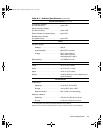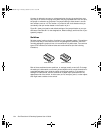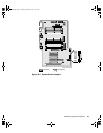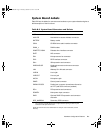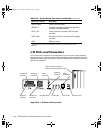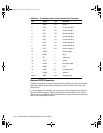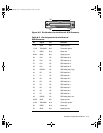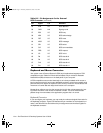
Hardware Configuration Features B-7
6HULDODQG3DUDOOH O3RUWV
The two built-in serial ports use 9-pin D-subminiature connectors on the back panel.
These ports support devices such as external modems, printers, plotters, and mice
that require serial data transmission (the transmission of data one bit at a time over
one line).
Most software uses the term COM (for COMmunications) plus a number to designate
a serial port (for example, COM1 or COM2). The default designations of your com-
puter’s built-in serial ports are COM1 and COM2.
The built-in parallel port uses a 25-pin D-subminiature connector on the computer’s
back panel. This I/O port sends data in parallel format (where eight data bits, or one
byte, are sent simultaneously over eight separate lines in a single cable). The parallel
port is used primarily for printers.
Most software uses the term LPT (for Line PrinTer) plus a number to designate a par-
allel port (for example, LPT1). The default designation of your computer’s built-in
parallel port is LPT1.
Port designations are used, for example, in software installation procedures that
include a step in which you identify the port to which your printer is attached, thus tell-
ing your software where to send its output. (An incorrect designation prevents the
printer from printing or causes scrambled print.)
$GGLQJDQ([SDQVLRQ&DUG&RQWDLQLQJ6HULDORU3DUDOOHO3RUWV
Your computer system has an autoconfiguration capability for the serial ports. This
feature lets you add an expansion card containing a serial port that has the same des-
ignation as one of the built-in ports without having to reconfigure the card. When the
computer detects the duplicate serial port on the expansion card, it
remaps
(reassigns)
the built-in port to the next available port designation.
Both the new and the remapped COM ports share the same IRQ setting, as follows:
COM1, COM3: IRQ4 (shared setting)
COM2, COM4: IRQ3 (shared setting)
These COM ports have the following I/O address settings:
COM1: 3F8h
COM2: 2F8h
COM3: 3E8h
COM4: 2E8h
For example, if you add an internal modem card with a port configured as COM1, the
computer then sees logical COM1 as the address on the modem card. It automati-
cally remaps the built-in serial port that was designated as COM1 to COM3, which
shares the COM1 IRQ setting. (Note that when you have two COM ports sharing an
IRQ setting, you can use either port as necessary
but you may not be able to use them
both at the same time
.) If you install one or more expansion cards with serial ports des-
ignated as COM1 and COM3, the corresponding built-in serial port is disabled, as
described in “Serial Port 1 and Serial Port 2” in Chapter 3.
23186bk0.bk Page 7 Thursday, October 29, 1998 11:07 AM



